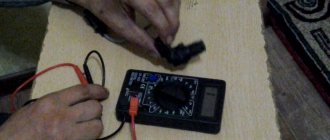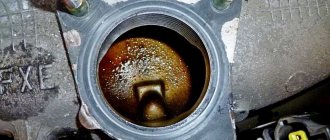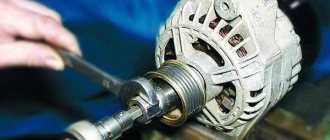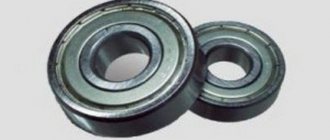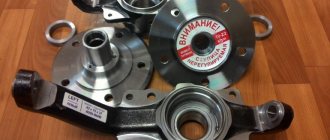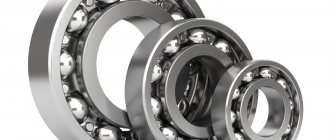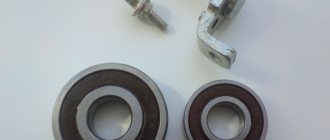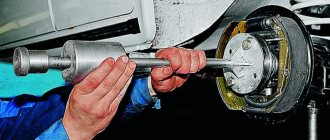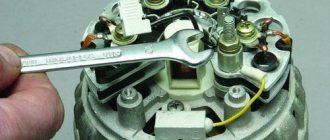Hello. Chassis repair is perhaps the most common work that a car owner has to do, or more accurately, “our” car owner has to do. These constant knocks and squeaks seem impossible to completely “defeat”, and after one is put in order, another goes out of order. In general, this is not strange, given the state of the roads in Russia. Constant loads and driving on uneven roads have the most unfavorable effect on the chassis. In principle, it would probably be wrong to blame the roads alone; part of the problem certainly lies with the designers of AvtoVAZ, who, despite problems with the roads, continue to produce cars with flimsy suspension and chassis. Well, enough of the ranting, I think, we need to get to work.
Today, dear readers of VAZ Repair, you will learn how to replace the support bearings on a Lada Granta, and not just replace them, but replace them without removing the struts. I wonder how? Then continue reading.
I’ll say right away that before replacing the support bearings, you need to make sure that they are really faulty. Read about how to check support bearings here.
Those who have ever encountered the need to replace support bearings know that to perform this work it is necessary to remove the struts along with the springs, which certainly complicates the task. However, as you know, laziness sometimes works wonders; in addition to being the “engine of progress”, it also often allows you to make your life easier. This photo report will clearly demonstrate to you how to replace the support bearings without removing the strut and you will be able to see that sometimes laziness can work wonders :-). Joke!
To work you must have:
- Set of keys: “13, 14, 17, 22”;
- Hexagon (to fix the rod from twisting);
- Two jacks or supports for the car;
- Special spring ties;
- Actually, the support bearings themselves.
Replacing support bearings on a Lada Granta without removing struts - step-by-step instructions
- We hang the wheel, then remove it.
- We unscrew the bolt securing the stabilizer strut, and then remove it so that it does not limit the travel of the strut.
- Next, take the hexagon and, holding the strut rod with it, loosen the fastening nut.
- We install the jack under the ball pin, and jack the rack, thereby removing the load from the second jack. At the same time, the stand will begin to “play” a little.
- We take the spring ties and attach them to the coils. We tighten the spring quite a bit, and then lower the jack installed under the ball. After these manipulations, the stand should go down.
- Now you need to unscrew the support bearing and rod; to do this, lower the rod down and pull out the “support” through the resulting void.
- We clean the rubber band and support cup from dirt. If you are going to install SS-20 supports, then the lower cup will not be useful to you.
Further assembly is carried out in reverse order. I recommend lubricating the bolts and nuts with “graphite” or at least working off, and after completing all the work, do not forget to tighten everything properly. We put the wheel in place and do the same with the second “support”, after which you can safely check the work. As you can see, in order to replace the support bearing on a Lada Granta, it is not at all necessary to completely dismantle the shock absorber struts.
That’s all I have, I hope this “life hack” will be very useful to someone and will significantly “make life easier.”
How to replace support brackets on Kalina yourself
To replace the bearing, in addition to a standard set of keys, you will need special pullers to remove the support and spring tensioner.
Unscrew the support and remove the stand
So, in order to unscrew the support we need a special key. With its help, we can easily unscrew the fastening nut as shown in the photo below.
We put a special wrench on the support nut; for ease of unscrewing, we will need a larger lever (a regular one with a diameter will do). We begin to unscrew the support as shown in the photo.
If you don’t have a special wrench at hand, then take a regular 22mm socket wrench and put it on the nut, use a 9mm wrench to hold the rod from turning and unscrew the fastening nut. After we have unscrewed the nut, we proceed to remove the shock absorber strut.
Disconnect the brake hoses that are attached to the strut. Next, unscrew the two bolts securing the strut to the steering knuckle. To easily unscrew them, we recommend spraying them with penetrating lubricant or WD40 and letting them sit for a couple of minutes. After this, you can easily unscrew the bolts without fear of stripping the threads.
Next, unscrew the nut securing the steering end to the strut. This can be done either using a special puller as shown in the photo, or knocking the tip out of the rack with a hammer. Now all that remains is to unscrew the 3 upper bolts securing the strut with the support to the body and pull out the strut.
Removing the old and installing a new support bearing
After we have removed the strut, we take two spring ties, put them on the spring and begin to tighten them until we can unscrew the nut. After unscrewing the top fastening nut, you can easily remove the support along with the bearing, cup and rubber band. If the anther is intact, you can leave it alone.
We take a new support bearing, put it on the stand and assemble the stand in the reverse order. Instead of factory rubber bands, you can install sound insulators from SS20, which are said to prevent squeaking. After we have assembled the rack with the new support, we remove the spring ties and install the rack in place.
Replacing the front wheel bearing without removing the strut, attempt 1
2) I will carry out all the work on site, so you MUST place a safety stop under the car. I used a removed wheel and a couple of wooden blocks as a stop.
At the same time, I decided to check how the jack was holding - that is, I left a distance of about a centimeter to the safety stop. 3) Unscrew the hub nut. I took the beard and, driving it into the groove in the shank of the CV joint, opened it with a hammer.
4) Now we have reached a difficult moment. To unscrew the nut, you need a 30mm wrench and a lever (a pipe at least 1 meter long). But that's not the problem. The tightening torque of the nut is very high (I can’t give the numbers). In order for the applied force to be used to unscrew the nut, and not to turn the hub, you can put a wheel on the hub with the decorative cap removed. Lower the car from the jack and then unscrew the nut. But even with the car lowered and the anti-roll stop, the wheel can slip on the floor (I had this happen.) Therefore, I use a device to fix the hub from turning. It is a faceplate (like a classic one) with fittings welded to it.
5) I put the clamp on the hub so that when the nut is unscrewed, it rests with a hook against the brake caliper bracket, resisting rotation. And tighten a couple (or all) of the wheel bolts.
6) I take a 30 socket wrench (I have a piece of pipe welded to it), put a lever on the shank - a pipe and unscrew the nut.
7) Now that the nut is unscrewed and the clamp does not need a bracket for the stop, I take an extended 17 socket, an extension and unscrew the two bolts that secure the caliper bracket.
By inserting a stronger screwdriver between the back of the brake pad and the inside of the brake caliper, we push in the piston of the brake cylinder (We use the screwdriver as a lever) so that it does not interfere with removing the caliper from the brake disc.
9) unfasten the brake hose from the mounting to the rack. (I warn you right away, be sure to return the hose to its place after assembly, otherwise when you turn the steering wheel, the hose will rub against the wheel and become worn out)
Causes of failure and how to check the support bearing of a VAZ 2110
The original supporter is capable of traveling 70-100 thousand km. But if used incorrectly, failure will occur earlier. For example, a breakdown can occur due to:
- dynamic driving style;
- ignoring the features of the roadway;
- liquid getting inside the part, which will wash out all the lubricant from the bearing.
The main symptoms of a malfunction will be:
- knocking noise when driving on rough roads;
- vibrations on the steering wheel when it rotates while driving;
- slow reaction to driver actions.
How to check the support:
Below is a video with verification recommendations:
Creak when turning the steering wheel in the area of the front wheel of a VAZ 2111:
How to check the support bearing of a VAZ 2110 strut:
vazoved
I drive a LADA VESTA CROSS, Moscow
Then there will simply be no one to pay the fines! This is a Korean 7 in 1 car tablet video recorder for Android..
I forgot about fines and Yandex Navigator.
There is FULL HD shooting, radar detector and GPS with 32 satellites. I got it at a reasonable price for just a few thousand here >>>> MORE...
Diagram and design of the unit
This photo shows a diagram of the front suspension of the car with a list of main elements:
Replacing the bearings without removing the strut is possible. | Topic author: Victor
I want to change the support bearings on a VAZ 2110, people say that you don’t even need to remove the strut and the camber doesn’t go astray, who has experience.
Ruslan Without removing it - no, but removing the strut along with the steering knuckle is possible, and the alignment will remain unchanged.
Gregory experience EE)
Arthur Dim sucks at climbing, quickly remove the stand. In order not to do the camber, I remove the entire assembly, only unscrew the calipers and the steering rod.
Pavel Well, you should ask people how this is done.
Polina What's the problem?
Zinaida You don't have to do the alignment even if you remove the strut. The main thing is not to unscrew anything unnecessary.
Kirill, you can’t, you’ll have to remove the entire stand.
Lyudmila, the main thing is not to unscrew the steering tips, compress the spring with zip ties, push the shock absorber down and move the strut towards you a little and the support will be removed - difficult but POSSIBLE
Replacing the front shock absorber strut support: VAZ 2110.
6 Jul 2015 — 6 min. — Added by user Carville: production of auto parts and accessories TRIALLI strut support was used in the video. When replacing the support, you will need to remove the shock absorber strut. . Replacement .
How to open a Kia Spectra without a key video in Russian
How does a heated steering wheel work on a BMW 760 Long 2004
How to change a lamp in a Ford Focus 2 headlight
How to change the support bearing on a VAZ 2109 without removing the strut: comments
I absolutely agree with you. This is a good idea. Ready to support you.
As a specialist, I can help. I specifically registered to participate in the discussion.
In any passenger car, regardless of design, the suspension must provide a smooth ride, good handling, each element of the chassis plays its role, and there are no unnecessary spare parts. The support bearing is a part of the front suspension, without which it is impossible to imagine a front-wheel drive car; if it were not there, the steering wheel would turn very tightly, with a terrible squeak, and it would be impossible to drive the car.
Guide to assembling new parts into a suspension element
At the very beginning, you need to put a bump stop on the suspension rod, which comes with the boot.
If you are going to install new springs, then initially they need to be tightened in the same way as the old ones. After the springs are tightened, we put them in place. In this case, you need to make sure that the spring falls into a special recess.
Having installed the spring, you need to prepare the support with the bearing. To do this, insert a bearing into the support.
A special flange is installed on top of the bearing and a rubber seal is installed on top of the flange.
We mount the assembled element onto the suspension rod and tighten the fixing nut.
When tightening the nut, you should control the rod so that it does not turn. It should turn out that the upper coil of the springs fits completely onto the sealing rubber. Thus, the front suspension of the Lada Kalina is assembled.
After completing the assembly, the tie elements should be removed from the spring. It is important to find the marking arrows on the spacer that indicate the direction of movement of the machine. Now we insert the entire stand assembly into the glass. After three bolts fall into the holes, screw the nuts on top. Next comes the most painstaking process of getting the strut into the steering knuckle. After that, we twist everything and tighten it to the end. Replacing Kalina front struts is not a very difficult process if you do everything correctly and in the right sequence. When you take on the suspension bulkhead from the second side, everything will work out much faster. And finally, after completion of work with the replacement of front suspension elements, it is necessary to carry out a procedure to regulate the alignment. This procedure will be carried out very quickly and efficiently in a car service center. Doing this yourself without skills is quite difficult and can only make things worse. It is best to go to a car service immediately after completing work on replacing the suspension elements. If you delay this, you will most likely have to change the tires as well. Tire wear is not the worst thing, but since all corners are broken when reinstalling the suspension strut, you can get into an accident when turning.
Why do you need a support bearing?
The question of why a support bearing is needed is asked by many novice car enthusiasts, but before you figure it out, you need to understand how shock absorber struts work and are installed. Shock absorbers in a car are designed to ensure a smooth ride, smooth out shocks and vibrations when driving on uneven roads, bumps and potholes. On front-wheel drive cars, the struts are attached to the body at the top, to the so-called “glasses”, and at the bottom they are connected to the steering knuckles. The support bearing (PU) is often called the upper shock absorber support; this generally simple device plays a very important role in the suspension of the car, and if it is faulty, it will become difficult to drive the car. It is necessary to monitor the condition of the supports and replace them in a timely manner - we must not forget that traffic safety depends on them.
A typical OP consists of three parts:
- an upper metal plate with fasteners (most often these are three studs);
- lower base;
- directly to the bearing itself.
The lower and upper plates are rigidly connected to each other, the bearing itself is usually pressed into the body of the support, and the design options for the OP can be different; each automaker uses its own design solutions. With the help of a support, the shock absorber strut is fixed to the body; due to the OP, the shock absorber rotates smoothly relative to the body, with no play.
We do our own replacement of front suspension elements on Lada Kalina
The car suspension is one of the main elements. It is the suspension that creates ride comfort and also makes handling more responsive and enjoyable. If the operation of this element is disrupted, a number of unpleasant situations are possible that you can get into (ranging from unpleasant knocking and creaking up to an accident). In this regard, such close attention is paid to the suspension during inspection. This article will discuss the complete replacement of the front suspension elements of the Lada Kalina. The Lada Kalina suspension elements that require the most frequent replacement include: struts, springs, supports and support bearings. If there is no severe rust on them, then the replacement procedure can be completed in a few hours. To make replacements in the suspension, you must have the following tools: 1. Balloon; 2. Jack; 3. Hammer; 4. Mount; 5. Keys for 9, 17, 19 and 22; 6. Similar to keys in head size; 7. Pliers; 8. Head 13, equipped with a wrench or ratchet; 9. Lubricant that promotes corrosion and rust removal; 10. Devices for compressing springs.
What types of support bearings are there?
The upper shock absorber mounts on different car models can differ significantly in design and mounting;
- with two or three studs;
- with threads in the body of the cup for screwing in bolts.
To dampen oscillations and vibration, shock absorber cups often have a rubberized surface or separate elastic elements, and the bearing itself can be pressed out and replaced.
What other support bearings are there? There are car models on which the upper support is not attached to the body “glass” with studs or nuts; the shock absorber is held in place by the upper steel plate. A wide metal washer is secured here with a nut screwed onto the shock absorber rod; to ensure a soft connection, a rubber spacer is placed under the plate (a similar design is found on the Chery Amulet car).
In some designs, the upper support consists of several parts; they may contain separate upper and lower cups, rubber buffers, and the bearing itself. When assembling the shock absorber strut, all parts are installed in a certain order; they must not be mixed up.
We change bearings correctly!
Actually, there are no difficulties in changing the bearing on Kalina. The main thing is to follow the step-by-step instructions that we will give below, and you will be able to deal with this trouble without any problems. So, to replace these components you need:
- Place the car on a flat surface and put it in gear.
- Remove the wheel from the side from which the bearing will be replaced.
- Remove the tie rod end nut. To do this, you will need a 19 mm wrench and pliers for removing the cotter pins.
- Use a special puller to remove the tip pin from the stand. If you don’t have a puller at hand, you can knock it out by prying it from below with a small crowbar.
- We tighten the nuts securing the strut to the steering knuckle. To do this we will need a 19mm wrench and possibly a 17mm wrench to support the bolt heads.
- Remove the nuts securing the shock absorber to the body. To do this, use a 13 mm socket wrench.
- We remove the shock absorber, install it on the tie spring and compress it until its upper part appears.
- Remove the nut of the upper shock absorber support. To do this you will need keys for 9 and 22.
- We are replacing the bearing.
- We assemble and install the shock absorber in the reverse order.
As you can see, the procedure is absolutely elementary and will not take much time; the most important thing is to do everything in accordance with the steps indicated above. If any points remain unclear to you, it is advisable to watch the video instructions for replacing the support bearing with and without removing the strut. Remember, you should not delay in eliminating malfunctions of this kind, because they can lead to more serious consequences, and you will need to spend a lot of money to eliminate them.
Front shock absorber support bearing faults
Like any parts in a car, OPs wear out and break over time; these suspension elements have their own service life. For each car model, the shock absorber supports have their own service life; on average, parts can last from 50 to 100 thousand kilometers without replacement. But for various reasons, support bearings can fail prematurely; the main causes of failure are:
- driving a car on bad roads;
- poorly performed repairs (for example, during installation the nuts were not fully tightened);
- low quality of spare parts or defects, most often non-original parts are of poor quality;
- destruction of the OP as a result of an impact (when hitting an obstacle or due to an accident);
- ingress of dirt and moisture onto the parts of the “support”; on many car models these parts are not protected in any way.
To make sure that the upper support is faulty, it is necessary to carry out diagnostics; in general, checking the support bearing is not difficult, but it is better to diagnose the suspension together.
How to replace the front support bearing and strut on a VAZ 2110
The support bearing of the VAZ 2110 is one of the important parts of the chassis. Thanks to it, the shock absorber can easily rotate around its own axis without pushing through the upper part of the mount. This ensures the durability of the suspension itself and also guarantees comfortable driving.
With proper operation, the part should fail only after 70-100 thousand km. However, situations arise when repairs will be required sooner. You can learn how to recognize a malfunction in time, diagnose a breakdown, or professionally replace a VAZ 2110 support bearing with your own hands from this article.
How to check the serviceability of the front strut support
The OP check is performed when the car is parked on a level surface; there is no need to hang the wheels. Diagnosis is carried out as follows:
- one of the inspection participants in the front rocks the car up and down;
- another person performs a visual inspection to see if there are any gaps.
Additionally, you can turn the steering wheel and observe the behavior of the shock absorbers, put your hand on the upper support while rotating the steering wheel or rocking the car - if there is play, you will feel it with your hand; clicks and squeaks may also be heard. Another diagnostic option is to grab the top cup protruding above the glass and try to rock it from side to side, in this case the play will also be noticeable.
The main signs of a malfunctioning front bearings
The following signs indicate a unit failure:
- A clearly audible and clearly felt knock that appears in the area of the front wheel arches every time the steering wheel is turned. Quite often such a knock is transmitted through the steering wheel. In addition to knocking sounds, there are creaks and dull noises when turning.
- Significant deterioration in vehicle controllability, deterioration in the quality of steering.
- Spring breakage.
Of course, knocking may not always be transmitted to the steering wheel. It all depends on the type of car, its brand and design features. But this should not reassure the driver. Failure to take timely measures can lead to complex repairs.
How to spot signs of trouble
If you have to constantly “steer” while driving on a dry, flat road, the part will most likely need to be replaced.
To determine performance, you must perform the following steps:
- Remove the protective caps, then press the upper element of the rod with your hand.
- Rock the car slightly (first longitudinally, then transversely).
- If the test sample is faulty, a characteristic knock will be heard.
- Have someone sit behind the wheel and turn the steering wheel from side to side;
- If the suspension element is worn out, you may feel a kickback in your hand, and you will also hear a metallic knock.
Determining the malfunction of the shock absorber and bearings:
Support bearing cost
The upper support of the front strut is a relatively inexpensive part; the cost of a spare part depends on the car model, brand, design features; it is no secret that car shops can sell the same spare parts at different prices. The approximate price of a shock absorber bearing is from 150 to 2200 rubles; for prestigious foreign cars, parts usually cost significantly more; you can buy cheaper ones from non-original production. As you can see, the range in prices for these spare parts is quite large; the most expensive bearings are sold for cars:
- Mazda 3;
- Toyota 4Runner/ Avensis;
- Nissan Juke;
- Honda CR-V;
- Mercedes W204;
- Lexus RX300;
- BMW X6.
At a very affordable price you can purchase support bearings for such car models as:
- Chevrolet Lacetti;
- Daewoo Matiz;
- Honda Fit;
- Nissan Almera;
- Chery Amulet;
- Hyundai Accent.
Support bearings for Chinese and Korean cars are generally inexpensive; spare parts for brands such as BMW, Audi, Lexus, and many purely American cars are almost always more expensive.
How to identify a malfunction
Are you bothered by some strange sounds in the chassis? Can you clearly hear its knocking while driving? This means that you urgently need to assess the condition of the suspension, since it is possible that you had to deal with:
- bearing damage;
- damage to the gasket.
There can be many reasons for the failure of support bearings, and they are the same for the vast majority of cars, including the Lada Kalina. First of all, we are talking about problems such as:
- Wear of the element (as a rule, the service life of support bearings on the Lada Kalina is designed for 50,000 - 100,000 km).
- Getting dirt and dust inside, which is very important for most of our regions where there are practically no roads.
- Damage due to excessive load on the shock absorber.
- Failure due to damage to the shock absorber itself.
Determining whether a support bearing is damaged is quite simple. To do this, you need to open the hood of the car, remove the “glass” and slightly rock the front of the car. A characteristic sound and vibration will indicate that you urgently need to replace 1 or 2 front support bearings. Of course, it’s better not to let things go wrong and install new components at least once every 50,000 – 70,000 kilometers (depending on the intensity of use of your Kalina). If a knock does appear, you should under no circumstances ignore it, since a new strut will cost you 4 to 10 times more than replacing a bearing, the average price of which is 300 rubles. The cost of work at a service station will also cost no less than 500 rubles. If you make the replacement yourself and in a timely manner, you can save a lot of money, especially since there is nothing complicated in the procedure. Next, we’ll talk about how to change the support bearing on a Lada Kalina car without contacting specialists.
Replacing the support bearing
Changing a support bearing is not very difficult, and almost every driver can do the job if he has the necessary tools and at least a little plumbing experience. It is more convenient to replace the OP in a pit or a car lift, but it is also possible to carry out repairs on a flat area, for example, in a garage or on the street near the house.
What kind of keys are required for repairs depends on the specific car model; in addition to combination and ring keys, sockets with collars, hexagons and sprockets are often used. To change the support bearing, it will be necessary to remove and disassemble the shock absorber strut, so in any case you will need:
- hammer;
- screwdrivers;
- pliers;
- mount;
- set of spring ties;
- remover of ball joints (steering rods).
Cars such as Mitsubishi, Renault or Chevrolet often require keys of non-standard sizes - 16, 18, 21 and 23.
What supports to put on Kalina
The choice depends on you and your budget. Today, manufacturers offer us a large selection of support bearings from 300 rubles to 3000 rubles. Which ones to install is up to you to decide. You can purchase factory supports, or you can choose an option from another manufacturer. The most popular supports are:
- Rack support FENOX price from 500 rub.
- Rack support Balakovo price from 350 rub.
- Rack support TRACK price from 800 rub.
- Rack support BZAK price from 600 rub.
- ASOMI supports, Tolyatti price from 3000 set
- Supports SS-20 Togliatti price from 3500 rubles set
Some car enthusiasts, for the so-called suspension tuning, install ASOMI or SS20 supports.
How to change the support bearing on a VAZ-2115 car
To replace the OP without a lift, the car will have to be jacked up; before starting work, stops should be placed under the rear wheels. Next we perform the following steps:
- unscrew the hub nut, for this purpose you will need a 30mm head with a wrench or pry bar (depending on the design of the head);
- remove the front wheel on the side where the bearing will be replaced, hang the car on a jack, and install a stand under the threshold to secure it (you can use a wooden block);
- Having pulled out the cotter pin with pliers, unscrew the nut holding the steering tip, using a puller, disconnect the tip from the shock absorber strut;
- unscrew the two caliper bracket bolts (13 wrench), if necessary, hold the caliper guide with the “17” wrench;
- move the caliper to the side on the brake hose;
- disconnect the ball joint (two bolts) from the steering knuckle, move the assembly with the axle toward you, freeing the hub from the CV joint splines;
- from above, under the hood, tighten the three nuts of the upper support (13 wrench);
- Having removed the rack assembly, use zip ties to compress the spring evenly on both sides;
- Having fixed the shock absorber rod in a stationary position with a special wrench, use a 22 mm head to unscrew the nut that holds the entire structure, including the support bearing;
- Next, remove the old bearing from the rod, install a new bearing without removing the couplers, tighten the nut to 22 until it stops;
- loosen and remove the ties and assemble.
Some car owners recommend using a gas wrench instead of a special wrench to hold the shock absorber rod, but this is not recommended; you can scratch the mirror surface, and then the shock absorber will leak.
Since many VAZ models have an identical suspension design, exactly the same as on the VAZ-2115, replacement is carried out on cars 2108-09-099, 2110-11-12, 2113-14. Due to the fact that with this sequence of operations the steering knuckle is not disconnected from the shock absorber strut, wheel alignment is not necessary after repair.
What types of malfunctions are there?
Most often, the first signs of problems with the support bearings will be knocking sounds in the suspension. A heavily worn and loose bearing will make this sound at every significant bump.
Depending on the design, the shock absorber rod can either be connected to the inner race of the bearing, or secured through a bushing and a rubber damper on the body.
In the first case, bearing wear will more significantly affect the car's handling, camber and caster angle settings, and therefore can be noticed even before knocking occurs.
As already mentioned, the sealing of the unit from road dirt and moisture leaves much to be desired. As all this accumulates in the bearing, it intensively corrodes and begins to make sounds of a different kind, reminiscent of creaking and crunching.
If such a part is disassembled, the picture will be characteristic - the cavity between the clips is occupied by rusty fragments of former balls or rollers.
Some Tips for Replacing the Front Shock Absorber Upper Mount
- When disassembling, the hub nut should be loosened before you remove the wheel; if the car is already suspended on a jack, it will not be easy to move it.
- If you do not have a ball joint and tie rod remover, the steering tip can be knocked out by hitting the joint joint with a heavy hammer, the blows must be sharp and precise. Even if the tip seriously “boils” in the connection, after several attempts it will still come off.
- To make it more convenient to disassemble the shock absorber strut after removal, you can immediately (while the shock absorber is still on the car) loosen the shock absorber rod nut.
- To make the nuts and bolts easier to turn off during the next repair, it is recommended to treat the fasteners and threads with graphite lubricant during assembly.
- When removing the shock absorber assembly with the hub and steering knuckle, it is a good idea to check the condition of all suspension parts on this side of the wheel. Such diagnostics will save your money and time, because it is often discovered that along with a defective support bearing, for example, a shock absorber is also faulty, or the outer CV joint has a large amount of play.
- You need to compress the spring with ties gradually, squeezing the coils little by little on one side and the other. The spring is compressed until the upper support begins to rotate freely; too much compression of the coils is not required, and in general it is unsafe.
In general, replacing the support bearings on the front struts is quite simple; to make a replacement, you don’t have to go to a car service center; you can do the work yourself.
Important features of installing the front shock absorber strut mount
- If the suspension has not been disassembled for a long time, 1 day before repair you should clean all components and connections from dust and dirt. Next, carefully treat with a special deep-use lubricant (this will make it easier to unscrew the connected parts);
- be sure to use a special spring tie;
- special attention must be paid to the accuracy of the position of the spring when installing it;
- the end of the coil is attached to reinforced places on the lower plate and shock absorber rod;
- install the beginning of the spring coil in the deepest part of the insulator;
- before installing the shock absorber in place, it is necessary to “bleed” it by making 5-6 movements;
- before installation it is necessary to lubricate the part;
- when installing the rack in its original place after replacing the front element, you will need to use a torque wrench; all tightening of threaded connections must be made with the most accurate force.
Shock absorber knock and support support replacement:
Problems with the operation of the front upper supports
The maximum service life (operational) of the element is 100 thousand kilometers. During everyday use, this part is constantly subjected to the highest loads.
The most common causes of support bearing failure are:
- mechanical loads;
- aggressive driving;
- hitting potholes;
- metal fatigue;
- corrosion;
- high humidity;
- dust, dirt, tiny particles of sand;
- chemically aggressive environment.
Most often it fails due to mechanical wear, deformation, rust on the surface outside and inside, and lack of lubrication.
The procedure for replacing a bearing on a VAZ-2110
In order to cope with the replacement of a part relatively quickly, you will need to prepare in advance all the necessary tools - a standard set of keys, a spring tie, a mechanical steering wheel end puller and a jack. In addition, it is important to choose the right support bearing itself, which must meet the specifications of your car.
The replacement procedure does not take as much time as it might seem at first glance, and includes several main steps:
- We install the car on a perfectly flat, hard surface and dismantle the hub cap;
- Unscrew the CV joint nut using a wrench or a special socket. At this point, you will need help to press the brake pedal at the same time;
- lift the car using a jack and remove the wheel;
- remove the cotter pin of the steering tip nut using a special puller, then completely unscrew it;
- remove the finger, which will have to be pressed out with very noticeable force;
- unscrew the bolts holding the ball joint and dismantle it;
- remove the brake hose, after which you need to unscrew the bolts holding the caliper and move it slightly to the side. This will allow you to reach the bearing without interference;
- pull out the CV joint, compress the spring using the tie mentioned above and remove the support bearing;
- Carefully install a new support to replace the worn one, after which we reassemble in the reverse order.
Kinds
For the VAZ 2109, several types of support bearings are used, each of which has its own characteristics.
| Bearing type | Peculiarities |
| OP with built-in ring | The built-in ring can be internal or external. This bearing has a mounting hole and does not require pressure flanges. Plus, the element is equipped with built-in gaskets that guarantee rotation accuracy. This support bearing is used to rotate both rings - inner and outer |
| OP with detachable inner ring | This design with a detachable inner ring serves to rotate the outer ring. The outer ring is in contact with the body. If you require maximum rotation accuracy of the outer rings, it is recommended to use this type of OP |
| OP with detachable outer ring | Here everything is the other way around, the design is designed to rotate the inner ring. In this case, the inner ring is in contact with the body, and the outer ring can be separated. Used in situations where precise rotation of the inner ring is required |
| Single-separated OP | This OP provides for the presence of a separation of the outer ring at one point, which helps to increase the rigidity of the bearing. Serves for situations requiring precise rotation of the outer ring. |
Consequences of bearing wear and signs of damage
Since the support bearing can be partially attributed to the steering (without it, rotation of the rack would be impossible), its failure primarily affects the controllability.
But here it should be noted that this depends on the design solution used.
For example, in a VAZ-2110, the inner race of the bearing acts as a bushing through which the shock absorber rod passes.
As a result of critical wear of the bearing, it begins to play and the rod is able to deviate from the axis.
The result of this is a violation of the wheel alignment angles, and consequently a deterioration in the car’s handling, as well as accelerated tire wear.
But on a car, where the bearing only provides rotation of the strut and does not interact with the shock absorber, alignment violation practically does not occur, since the rod is kept from axial displacement by a bushing pressed into the rubber damper.
But even with this design, bearing wear will have a negative impact on handling.
If the bearing has worn out, this will naturally begin to show. In this case, the symptoms of a malfunction depend on the design.
If we take the same VAZ-2110, then bearing wear will manifest itself in the form of knocking noises when driving over potholes and unevenness on the road; in addition, they can be heard when turning. Sounds in the support are caused by play in the support element; it is important not to confuse them with a knock in the shock absorber.
In the case of a bearing that does not interact with the shock absorber, its malfunction most often manifests itself in the form of squeaks and squeaks when turning.
